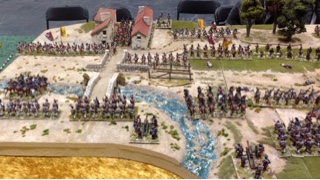That's another Salute come and gone. We will pass quickly over my trip to Brighton the night before for the footie - grim on all counts. I am not a huge fan of Scotrail, but all is almost forgiven after travelling on Southern!
Fortunately, Salute didn't disappoint. The Warlords have cracked the queuing with the scanning and it was straight in. First a trip around the games, and very good they were. Then the traders. With no game at Craven Cottage in the afternoon, I had a couple of hours more than usual to empty my wallet. Flying back was a bit of a limitation, but I did remember to bring a larger cabin bag.
My purchases included the new Black Powder supplement for the ACW and the FoW Pacific war supplement for the Japanese. Other than that it was bits and bobs, the items you don't see often at other shows, particular scenic items. In particular, I had more time to look at the huge array of fantasy figures and pick up some interesting additions for my historical and fantasy armies. The imagination of game designers in coming up with new settings is truly amazing.
Here are the games that caught my eye.
First off is the Essex Gamers massive Vietnam War game utilising the mega Ron Ringrose collection.
The first game I saw on entering the hall was this Hammers Slammers game. Not my thing but the terrain was good.
Then Iron Cross the new WW2 rules that I recently reviewed. I think the buildings are from 4 Ground.
Very nice Frostgrave setting.
This Mexican Revolution game got me excited as this is the GDWS participation game at Claymore in August. However, this is in 20mm not 28mm, so no figure inspiration.
There were a lot of Martian games this year to go with the Steampunk theme.
Impressive Seven Years War game. Kunersdorf I think, a rare Frederick defeat.
I love these 54mm Napoleonics. If my eyesight deteriorates further I could be heading in this direction!
Impressive big scale age of sail with a well modelled land element.
This really looked like I imagine the Battle of Agincourt, with masses of French queuing up to attack.
They must have used a huge amount of snow flock for this Winter War on ice game
Lovely buildings in this Peninsular War game of the Battle of Adrados - al a Sharpe's Enemy, before you hunt through Chandler!
On the subject of buildings this town scene was very good too.
A fictional Seven Years War battle of Willhelmstadt with lovely scenic boards.
This was the better of the Kings of War games
But this one wins the prize for the busiest table I think I have every seen.
Finally, a shot from a stall selling big scale toy WW2 from a firm called Cobi. These are just brilliant. If it hadn't been for the baggage limitations I would have bought these for summer games in the garden!
























